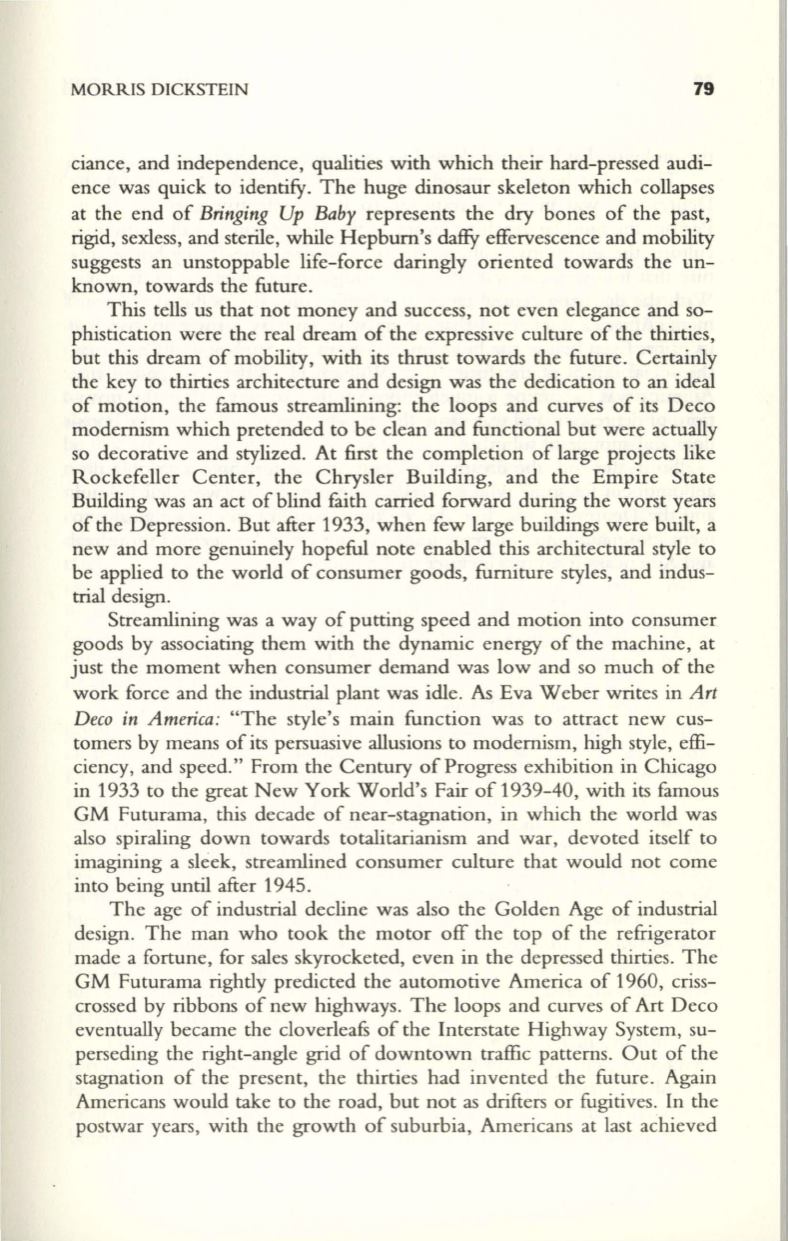
MORRIS DICKSTEIN
79
ciance, and independence, qualities with which their hard-pressed audi–
ence was quick to identify. The huge dinosaur skeleton which collapses
at the end of
Bringing Up Baby
represents the dry bones of the past,
rigid, sexless, and sterile, while Hepburn's daffy effervescence and mobility
suggests an unstoppable life-force daringly oriented towards the un–
known, towards the future.
This tells us that not money and success, not even elegance and so–
phistication were the real dream of the expressive culture of the thirties,
but this dream of mobility, with its thrust towards the future. Certainly
the key to thirties architecture and design was the dedication to an ideal
of motion, the famous streamlining: the loops and curves of its Deco
modernism which pretended to be clean and functional but were actually
so decorative and stylized. At first the completion of large projects like
Rockefeller Center, the Chrysler Building, and the Empire State
Building was an act of blind faith carried forward during the worst years
of the Depression. But after 1933, when few large buildings were built, a
new and more genuinely hopeful note enabled this architectural style to
be applied to the world of consumer goods, furniture styles, and indus–
trial design.
Streamlining was a way of putting speed and motion into consumer
goods by associating them with the dynamic energy of the machine, at
just the moment when consumer demand was low and so much of the
work force and the industrial plant was idle. As Eva Weber writes in
Art
Deco in America:
"The style's main function was to attract new cus–
tomers by means of its persuasive allusions to modernism, high style, effi–
ciency, and speed." From the Century of Progress exhibition in Chicago
in 1933 to the great New York World's Fair of 1939-40, with its famous
GM Futurama, this decade of near-stagnation, in which the world was
also spiraling down towards totalitarianism and war, devoted itself to
imagining a sleek, streamlined consumer culture that would not come
into being until after 1945.
The age of industrial decline was also the Golden Age of industrial
design. The man who took the motor off the top of the refrigerator
made a fortune, for sales skyrocketed, even in the depressed thirties. The
GM Futurama rightly predicted the automotive America of 1960, criss–
crossed by ribbons of new highways. The loops and curves of Art Deco
eventually became the cloverleafs of the Interstate Highway System, su–
perseding the right-angle grid of downtown traffic patterns. Out of the
stagnation of the present, the thirties had invented the future . Again
Americans would take to the road, but not as drifters or fugitives. In the
postwar years, with the growth of suburbia, Americans at last achieved


